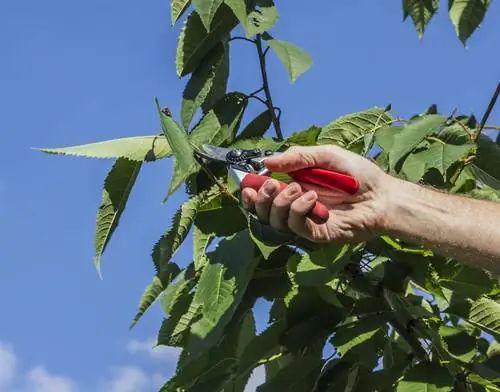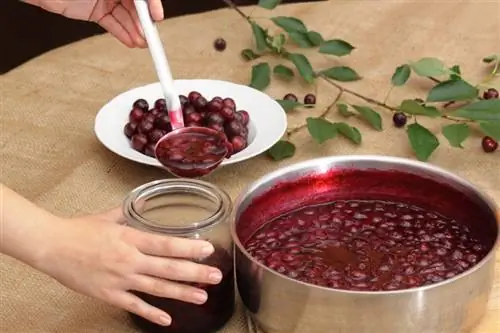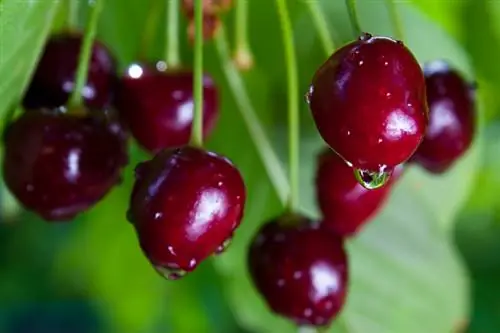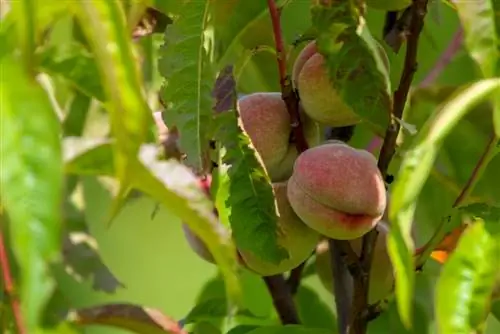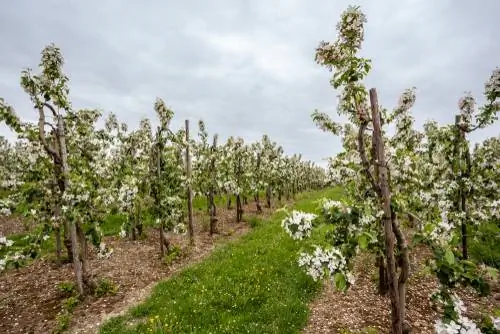- Author admin [email protected].
- Public 2023-12-16 16:46.
- Last modified 2025-06-01 06:02.
So that sour cherries thrive with a productive crown, pruning is on the schedule in summer. The cutting method differentiates between the variety types “Morelle Morelle” and “Sour Cherry”. Read this tutorial on how to cut your sour cherry in an exemplary manner.
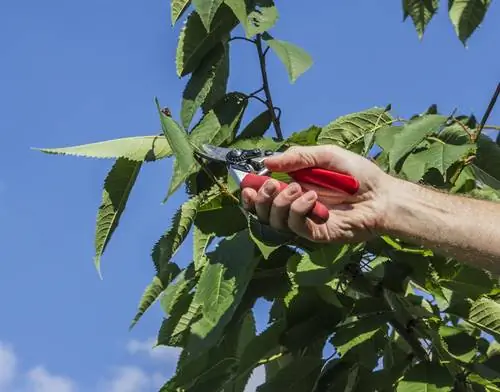
When and how should you cut a sour cherry?
Sour cherries should be pruned in the summer after harvest, with pruning varying depending on the variety type. Morello cherries require annual maintenance pruning, while sour cherries are pruned every 2 to 3 years. Remove weak, bare shoots and promote vigorous growth.
Variety types - differences in a nutshell
Sour cherries differ significantly from sweet cherries in their growth behavior. This circumstance primarily requires a different incision. Furthermore, the gardener should know which type of sour cherry thrives in his green kingdom. Pruning care takes this into account in many ways. The following overview summarizes the outstanding criteria of both types of varieties:
Morelle type
- Popular varieties: Gerema, Morellefeuer
- Blooms and bears fruit onannual wood
- Tendency to form long, bare whip shoots with few leaves at the outer end
Sour cherry type
- Popular varieties: carnelian, sour cherry, sapphire, agate, jade, Heimann's ruby sour cherry
- Blooms and fruits onone-, two- and three-year-old wood
- Characteristic feature: short fruit wood, richly decorated with flower buds and leaves
Tip
The distinction between variety types is lost if a sour cherry suffers from Monilia peak drought. If shoot tips dry out in the middle of the season, there is an immediate need for action. Cut all affected branches back to he althy wood. Then clean and disinfect the cutting tool carefully to avoid accidental transmission of the pathogens to other trees.
The best time to prune is in summer
Commercial fruit growing serves as a role model for hobby gardeners when it comes to choosing the best time to prune. As early bloomers, sour cherries lay their budsin the previous year. Subject the crown to maintenance pruning after harvest to promote this year's bud formation. Varieties of the typeShadowMorelleare cutevery year. For varieties of the typeSour cherrypruning care is on the program every2 to 3 years.
An exception applies to radical pruning measures, such as rejuvenating an old sour cherry. In this case, the summer grace period from March to September applies, which is prescribed in the Federal Nature Conservation Act. Extensive tree pruning is permitted from October 1st to February 28th, provided no wild animals overwinter in the treetop or bush.
Cutting morello cherries
Popular sour cherry varieties, such as Morello Morelle, Morelle Fire or Gerema, bloom and fruit on annual wood. This also means that the fruit trees tend to become bald. Furthermore, the young, thin shoots bend towards the ground under their juicy, sour load. This growth behavior with distinctive whip shoots requiresannual maintenance pruning, as illustrated in the figure below. How to cut correctly:
- The best time is after the harvest in dry, cloudy weather
- Cut back overhanging shoots by half to two thirds
- Derive each whip shoot to a deeper new shoot
- Important: Do not prune new shoots to promote vigorous growth
In conjunction with pruning worn-out whip shoots, you dedicate yourself to continuous rejuvenation of the crown. For this purpose, remove the oldest leading branch on Astring every two to three years. Alternatively, redirect the relevant scaffold branch to a young, outward-pointing side shoot as a successor.
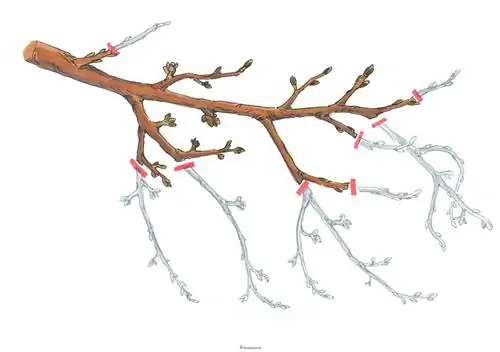
Morelle sour cherry varieties form long, bare whip shoots. After harvesting, cut back the bare canes vigorously.
Background
Steep branches do not bear fruit
If your sour cherry is dominated by shoots with an almost vertical growth direction, you will look in vain for flowers and fruits. A branch only turns into valuable fruit wood when it is at an angle of approximately60° to the trunk or leading branch. You should regulate a branch position that is too steep. This can be done easily with spreader bars, weights or string. The younger and more flexible the wood, the easier it is to flatten. The growth then calms down so that the first flower buds can form.
Cutting sour cherries
You will never have to worry about bare shoots on sour cherries of the sour cherry type. Popular varieties such as Saphir or Favorit impress with their upright growth. Flowers and fruits also thrive on older wood, without any signs of premature baldness. With this habit, sour cherries make pruning easy for the gardener. How to do it right:
- Prune sour cherries at 2 to 3 year intervals
- The best time is after the cherry harvest
- Crown cutting away weak, inward-facing or dead branches
- Cut steep shoots back to short cones
After three to four years, the fruit wood is almost exhausted and is often heavily branched in the upper area. With a targeted cut, you can breathe new life into the tired wood. Choose a young, one to two-year-old side shoot at the back. Cut off the old wood at the branch.

Sour cherry varieties bloom and fruit on one-, two- and three-year-old wood. Weak, unfavorable shoots and dead wood should be removed every few years. If shoots are too long, shorten them to promote the formation of short shoots as new fruiting wood.
Excursus
Cut off the fruit stalk instead of picking it off
The sword of Damocles of fruit tree cancer hovers over all fruit trees. This is a fungal infection and not cancer in the medical sense. The pathogens act aswound parasites and lie in wait for the smallest wounds in the wood. It pays to cut off every fruit stalk when harvesting sour cherries. Picking sour cherries leaves small wounds on the branch, which serve as a welcome target for cunning fungal spores.
Rejuvenate old sour cherries
Morella cherries age within a few years if pruning care is neglected. Without the occasional thinning cut, this fate is also sealed for a sour cherry. The crown turns into an impenetrable network of branches that becomes bare from the inside. Flowers and fruits are rare. However, that is no reason to clear an old sour cherry. Thegood pruning tolerance allows a radical rejuvenation cut that brings a breath of fresh air to profitability. How to proceed professionally:
- The best time is between the end of January and the end of February in frost-free, dry weather
- Start by sawing off dead wood on a string
- Drooping, trailing branches lead to a young side shoot at the base
The more old, senile branches you can divert to young side shoots, the better the tolerance of a rejuvenation cut. If no side shoots can be found, cut the relevant branch into tenons. Leave a stump of 10 to 15 cm. By the next summer or the summer after that, a number of young shoots will sprout from this spot. Choose the two most promising specimens with a diagonal-horizontal growth direction. Remove all remaining shoots along with the dried cone residue.
Frequently asked questions
Is the sour cherry self-fertile?
Sour cherries predominantly rely on a neighboring pollinator variety. This can also be a sweet cherry in your neighbor's garden, as long as both cherry trees bloom at the same time and there are enough insects around for pollination. Sour cherries offered as self-fertile generally benefit if there is another variety within a radius of 200 to 300 meters.
I planted the sour cherry variety Saphir 3 years ago. This year a lonely cherry is developing. What can I do to increase fruit yield?
It is not unusual for sour cherries to only bear fruit in the third year. At the beginning, the fruit trees concentrate on strong root growth and stable crown formation. You can improve flowering and fruit yield by applying a phosphorus-rich berry fertilizer from March to the end of July. Furthermore, the fruit yield increases if you plant a second sour cherry variety.
My sour cherry “Morellenfeuer” should not grow larger than 2,50 to 3,00 meters. When and how should I cut?
Under these circumstances, we recommend cutting twice a year. In summer, thin out worn fruit wood and remove bare, drooping whip shoots. Between the end of January and the end of February, prune the crown by a third wherever there are no swelling flower buds.
Can you tell me whether the sour cherry “Morelle” should be cut? If yes, when and how does it work?
Pruning of morello cherries should be done annually. It is recommended to prune at least a third of the removed, whip-shaped shoots. The best time is immediately after the harvest in overcast, dry weather. You should note the following premises: remove all shoots that grow steeply upwards, crossing and parallel shoots. Remove branches with growth direction towards the inside of the crown. Thin out the crown of the sour cherry as a whole so that light can reach all regions.
The 3 most common cutting mistakes
A sour cherry without picturesque spring blossoms and juicy fruits is usually the victim of a typical cutting error. In order to protect the readers of this tutorial from annoying damage and crop failure, the following table lists the three most common errors and gives tips for prevention:
| Cutting errors | malicious image | Prevention |
|---|---|---|
| cut in late winter | Loss of flowers and fruits | Cutting sour cherries after harvest |
| never cut | premature aging and baldness, decreasing crop yield | Prune morello cherries annually, cut sour cherries every 3 years |
| Steep shoots not removed or flattened | little fruit wood, dense network of sterile shoots | Tighten shoots that are too steep or spread them to a 60° angle |

Tip
Regular pruning care on sour cherries also serves as an effective prevention against the dreaded Monilia peak drought. By vigorously cutting back worn, old and susceptible wood, you remove existing spore deposits of the fungal disease. Please do not dispose of suspicious clippings in the compost, but instead put them in the garbage can or at the municipal composting facility.

